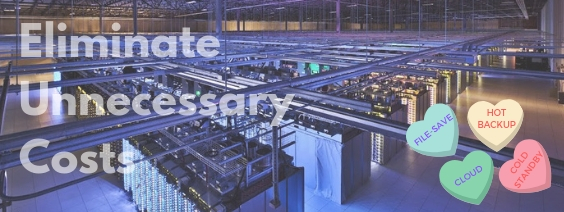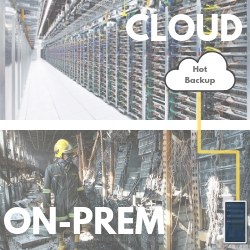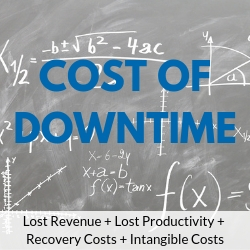Love Your Data? Fall in Love with Your Backups.
Your data and backups go hand in hand.
Data is the lifeblood of your business. What happens if you lost access to it, or even worse, lost your data altogether? Would your business survive? More importantly, do you have a disaster recovery plan in place? How you deal with it depends on how prepared you are.

The stories we tell here are true. We have changed the names to protect the innocent.
You may already know Phil and Phyllis from our video. They own Acme Corp. They have 50 employees and manufacture widgets. Their annual revenue is $20 million. They run their business on a PICK/MultiValue system and keep their server on-premise. Their PICK application has been running strong for over 25 years!
 One night, there was a major disaster at their business. A lightning strike caused a downed wire, resulting in a small fire in their building. This destroyed nearly all of their computer equipment in their on-premises computer room. Fortunately, this happened late on a Wednesday night and nobody was hurt. The fire was contained rather quickly. When Phil and Phyllis received a call early Thursday morning they realized they needed to put their backup strategy in place.
One night, there was a major disaster at their business. A lightning strike caused a downed wire, resulting in a small fire in their building. This destroyed nearly all of their computer equipment in their on-premises computer room. Fortunately, this happened late on a Wednesday night and nobody was hurt. The fire was contained rather quickly. When Phil and Phyllis received a call early Thursday morning they realized they needed to put their backup strategy in place.
So what do they do now?
Scenario #1 – Start over from Scratch (Most Expensive Option)
Phil and Phyllis do file-saves diligently every weeknight and even take a copy offsite. After the call, Phil calls his local data storage provider (like Iron Mountain) to retrieve the previous file-save. It was from Tuesday as their Wednesday file-save hadn’t begun yet due to the timing of the fire. They lost a whole day’s worth of work. He then has to go out and acquire and build a new server from scratch. He configures it and installs all the software and then does a file restore from his latest backup. Then he tests to make sure everything is working as it was. This all takes 4 days including the time it took to re-input all the data since the last backup.
The hourly cost of downtime – $3,701.48. (This amount is based on lost revenue and lost productivity in a $20 million annual revenue company with 50 employees.)
Estimated downtime cost for 4 days – $118,447.36
Scenario 2 – Utilize Their Cold Standby Server
Phil calls up his cloud provider and tells him the horrible news. He has a server all ready to go (his MultiValue database has already been set up and tested) – all he needs to do is have his cloud provider turn the server on, activate the MultiValue license and restore his latest file-save. Once that is done, they need to recreate the data that was lost since the last backup.
Number of days down – 1 (to input the lost data and restore the last file-save)
Estimated downtime costs $29,611.84
Scenario 3 – Switch Immediately to Their Hot Backup Server (Most Prudent Option)
 Phil and Phyllis are prepared. Not only did they receive a call about the fire, but they also received an email in the middle of the night that stated there was a disconnect between the primary and backup server. They have all their employees switch over to the new backup server. Since they had a plan in place, the employees already had a secondary IP icon on their desktops and knew exactly what to do. Their last transaction was there so no need to recreate any lost data. They continue to work as if nothing happened. Now their downtime is as minimal as an hour instead of days.
Phil and Phyllis are prepared. Not only did they receive a call about the fire, but they also received an email in the middle of the night that stated there was a disconnect between the primary and backup server. They have all their employees switch over to the new backup server. Since they had a plan in place, the employees already had a secondary IP icon on their desktops and knew exactly what to do. Their last transaction was there so no need to recreate any lost data. They continue to work as if nothing happened. Now their downtime is as minimal as an hour instead of days.
Number of days down – 0
Estimated downtime cost – $3,701.48
The scenarios above are just some of the ways our clients have recovered after a disaster. Some of these methods are more expensive than others and depend on when you want to pay the expense – by either paying a small monthly predictable expense now or paying an unexpected much larger expense later.
The disaster recovery scenarios above could have all been prevented if Phil and Phyllis had their primary server in the cloud to start with.
 How do you figure out what your downtime costs would be? The formula is shown to the left.
How do you figure out what your downtime costs would be? The formula is shown to the left.
An example of an intangible cost would be the cost to your brand if a potential customer was unable to purchase from your website and purchased from your competitor instead.
Just last month, our offices experienced a power outage for over three days. With the rains that hit Southern California, water got into an electrical conduit in the basement. This caused a huge electrical nightmare. Other than having to work remotely, we weren’t affected, because everything we have is in the cloud, so we were able to continue business as usual with zero downtime and zero effect on our clients.
Bad things do happen. And not just natural disasters and fires. Other top factors include outdated software and hardware as well as human error.
When was the last time you verified your backup? Or better yet performed a bare-metal restore? Do you have a plan in place for when bad things happen? We all have someday lists and hopefully, your Disaster Recovery (DR) plan isn’t on it. But if it is, make someday today and create a DR plan that works for you and your company before it’s too late.
The level of backup plan you need depends on a few factors including budget and level of risk you are willing to take. For example, how long can you afford to be down?
We can help you with your plan – whatever the level (file-saves, cold standby or hot backup.) We have backup options for every budget and can help you now before a disaster happens, or even after one happens.
We test and verify your backups for you. We provision a cloud server, verify your backup is working and then decommission the server. Easy peasy. You have peace of mind knowing your backup is valid. Believe it or not, we had a client who was doing daily backups, taking them offsite and when they needed to use it and tried to restore, the file-save tape was blank. You don’t want this to happen to you – especially at an inopportune time.
We can also create your cold standby and hot backup servers in our Google cloud, where they are not only secure but have an uptime of 99.999 % – this equates to just 5 minutes of downtime per year.
Bottom Line
Knowing exactly what risks you are willing to take, how long you can afford to be down and creating a DR plan that works for you can mitigate your liability when you are actually down and need to recover. Don’t be “penny wise and pound foolish” when it comes to your valuable data.
How can we help you take advantage of disaster recovery and other benefits the cloud has to offer?
Try our cloud FREE for 15 days with no credit card or commitment required. Once you try it, we think you will believe in the power of the cloud too.
